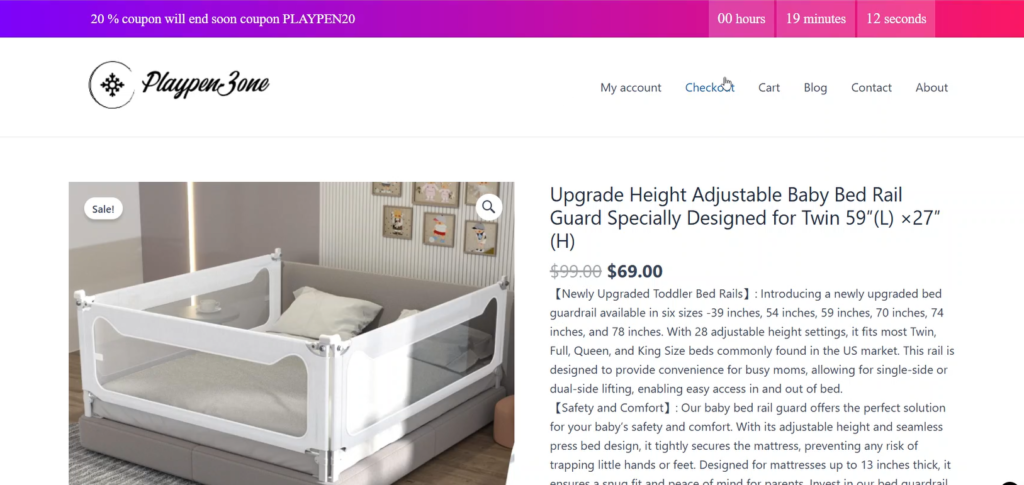
In today’s fast-paced digital marketplace, creating a sense of urgency is a powerful strategy for driving sales. One innovative method that has emerged is the use of user-based timers for short-term coupon displays. These timers, which can be set for durations ranging from 0 to 120 minutes, start ticking as soon as a visitor lands on your sales page. This article explores how leveraging this technique can create scarcity, boost conversions, and ultimately increase your sales.
Understanding User-Based Timers
User-based timers are countdown clocks that begin ticking as soon as a user lands on a webpage. Unlike traditional timers that start at a pre-set time for all visitors, user-based timers are unique for each visitor, providing a personalized sense of urgency. This customization allows businesses to create a more compelling reason for users to take immediate action, such as redeeming a limited-time coupon.
How User-Based Timers Work
When a visitor arrives on your sales page, the timer starts with a specified countdown. For example, if you set the timer for 30 minutes, each visitor will see a countdown beginning from 30 minutes as soon as they access the page. This individualized countdown gives the impression of an exclusive, time-sensitive offer that encourages quick decision-making. Here’s a breakdown of how this process works:
- Visitor Lands on Page: The user navigates to your sales page.
- Timer Starts: A countdown timer begins, displaying the remaining time to redeem the offer.
- Countdown Continues: The timer continues to count down regardless of user activity on the page.
- Coupon Display: The offer is prominently displayed alongside the ticking timer.
- Expiry: Once the timer reaches zero, the coupon becomes invalid, reinforcing the urgency.
The Psychological Impact of Scarcity
The principle of scarcity is a well-documented psychological trigger that can significantly influence consumer behavior. When people perceive that an opportunity is limited, they are more likely to act quickly to avoid missing out. This concept is rooted in the fear of loss, which often outweighs the desire for gain.
By implementing a user-based timer, you create an environment where the fear of missing out (FOMO) is heightened. Each visitor sees a personalized countdown, which suggests that the offer is fleeting and exclusive. This not only captures their attention but also motivates them to complete the purchase before the time runs out.
Creating a Sense of Urgency
User-based timers are particularly effective in creating urgency. Here’s why:
- Immediate Attention: The countdown clock immediately grabs the visitor’s attention, making it hard to ignore the offer.
- Time Pressure: As the seconds tick away, the pressure to make a decision increases, leading to faster conversions.
- Perceived Exclusivity: Visitors feel that the offer is tailored specifically for them, increasing the likelihood of a purchase.
Implementation Strategies
To maximize the effectiveness of user-based timers, consider the following implementation strategies:
- Strategic Placement: Place the timer and coupon code in a prominent location on your sales page where it’s easily visible. The top of the page, near the product description, or as a sticky banner are good options.
- Clear Messaging: Clearly communicate the benefits of the offer and the consequences of not acting quickly. Use phrases like “Limited Time Offer” or “Only X Minutes Left!”
- A/B Testing: Test different durations for the timer to determine which time frame yields the highest conversion rate. While 30 minutes might work for some offers, others might perform better with a 60 or 90-minute window.
- Mobile Optimization: Ensure that your timer is fully functional and visible on mobile devices. Many users access sales pages via smartphones, so a seamless experience across all platforms is crucial.
- Integrate with Email Campaigns: Use email campaigns to drive traffic to your sales page and mention the time-sensitive nature of the offer to entice more clicks.
Case Study: Success Stories
Several businesses have successfully implemented user-based timers to increase their sales. For instance, an e-commerce retailer that sells fashion accessories introduced a 20-minute timer for a 10% discount coupon. They noticed a 35% increase in conversion rates during the promotion period. Customers reported that the ticking clock encouraged them to make quicker purchasing decisions.
Another example is a software company that offered a 60-minute window for a 15% discount on their annual subscription. By promoting the timer on their landing page and through targeted email campaigns, they saw a significant uptick in sign-ups, as customers did not want to miss out on the limited-time offer.
Overcoming Challenges
While user-based timers are highly effective, they can also pose challenges. One potential issue is the perception of manipulation. If users feel that the timer is not genuine or that the offer is not truly limited, it can lead to distrust and harm your brand’s reputation. To overcome this, ensure that your timers are transparent and that the offers are genuinely time-sensitive.
Enhancing the User Experience
To further enhance the user experience, consider combining user-based timers with other engagement tools. For example:
User-based timers for short-term coupon displays are a powerful tool for creating urgency and driving sales. By leveraging the psychological principles of scarcity and urgency, you can encourage quicker purchasing decisions and increase your conversion rates. When implemented thoughtfully, these timers can enhance the user experience and create a sense of exclusivity that keeps customers coming back for more.
To fully realize the benefits of user-based timers, ensure that your implementation is strategic, transparent, and aligned with your overall marketing goals. With the right approach, you can transform casual visitors into loyal customers who are eager to take advantage of your limited-time offers.